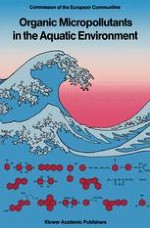1988 | OriginalPaper | Buchkapitel
Effects of Chlorine Dioxide Preoxidation on Organic Halide Formation Potentials
verfasst von : H. Ben Amor, J. De Laat, M. Dore
Erschienen in: Organic Micropollutants in the Aquatic Environment
Verlag: Springer Netherlands
Enthalten in: Professional Book Archive
Aktivieren Sie unsere intelligente Suche, um passende Fachinhalte oder Patente zu finden.
Wählen Sie Textabschnitte aus um mit Künstlicher Intelligenz passenden Patente zu finden. powered by
Markieren Sie Textabschnitte, um KI-gestützt weitere passende Inhalte zu finden. powered by
The aim of our study was to determine the effects of a preoxidation with chlorine dioxide on the production of organohalogenated compounds (trihalomethanes, dichloroacetic and trichloroacetic acids) formed from the chlorination of different raw surface waters and of isolated aquatic humic substances. Samples of natural waters and of fulvic and humic acid solutions were oxidized for a reaction time of 24 hours with increasing doses of chlorine dioxide (from 0 to 2.5 mg of ClO2 per mg of TOC), then heavily chlorinated (chlorine doses: 40–60 mg l−1, reaction time: 72 hours). The results obtained with laboratory experiments showed that surface waters consumed about 0.7 mg ClO2/mg TOC after a reaction time of 24 hours and fulvic and humic acids about 1.6 mg ClO2/mg TOC. For doses of chlorine dioxide corresponding to the above values of demands, the experiments showed that there was a significant decrease in the formation potentials of trihalomethanes (45–55%), of dichloroacetic acid (30–40%) and of trichloroacetic acid (40–60%) as well as in the chlorine demand during postchlorination (10–20%). Compared to chlorine, chlorine dioxide produced very small amounts of organohalogenated compounds. Furthermore, the production of chlorite and the concentration of organic matter (Total Organic Carbon and UV absorbance measurements) were also measured during our experiments.
